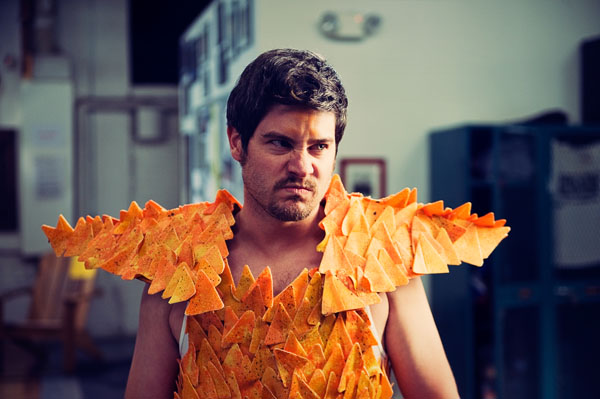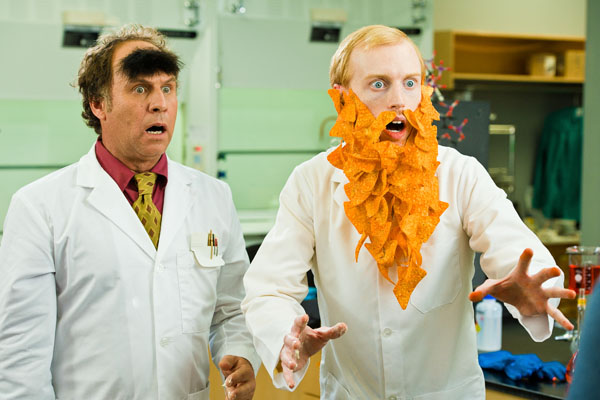Share
Things You’ll Never Photograph: A Doritos Commercial
In our latest installment of Things You’ll Never Photograph, Dmitry Futoryan takes us on the set of a Doritos commercial to capture action and ...
In our latest installment of Things You’ll Never Photograph, Dmitry Futoryan takes us on the set of a Doritos commercial to capture action and behind-the-seen images.

What is your photographic background?
I originally went to school for sound engineering, and had been working as a production sound mixer (recording sound on set) for about a year when I started getting really interested in Photoshop and all the things you could do with it. I kept seeing these amazing images that featured heavy compositing, photo-manipulation, and 3D elements, and I really wanted to create work of my own that had that level of depth and complexity.
I was using a lot of stock photography in my projects and paying crazy money for these high-res images, that at one point, I decided I would just shoot them myself. I figured it would give me more creative freedom to shoot EXACTLY the images I wanted, rather than adapting my project to suit what was available in the stock libraries. So in late 2009, right before a trip to Europe, I bought my first dSLR.
Most of the technical aspects I learned by making every newbie mistake possible! I also had some help from places like Lynda.com, Kelby Training, and the wonderful internet.

How on earth did you get involved with on set photography? It’s seems like such a niche type of photography.
After I came back from my trip to Europe, I was showing a few friends the images I’d taken, and Cole Koehler, one of the writers/directors/actors for the Doritos spot, asked if I’d be interested in shooting some stills on set. At that point I still had no clue what I was doing, but I figured that if I show up and shoot whatever I thought looked cool, it would all work out. Needless to say I had a fantastic experience that day, and knew that my immediate focus would become shooting stills.
Is shooting production stills 100% of your photo business? Or do you do other types of photography as well?
My focus at the moment is on production stills, but in the future I’d like to add more commercial and editorial work to my portfolio. I also have a few personal projects that I’m working on, but I haven’t started thinking about how I’d like to present them to the world quite yet.
The next step for me is to start blogging about my experiences on set, and sharing what I’ve been given the opportunity to learn so far. It’ll also make a great outlet for the images that I love, but don’t fit the theme of my current portfolio.
I imagine you’re using a “blimp” to suppress the shutter noise? What type of equipment do you typically have on set?
Up until very recently I’ve been shooting without a blimp, but I’m at a point where investing in one will allow me to take my stills to the next level. There are many opportunities to shoot when sound isn’t rolling, but it limits your chances of capturing “the shot”. I just ordered a Jacobson Sound Blimp this week, and I’m excited to see how it changes my approach to shooting production stills.
I’m a total gear-nerd, but I try to keep my kit limited because having extra mobility gives you a huge advantage when trying to cover a lot of locations in a given day. I usually carry two backpacks, one for camera gear, the other for data-management.
The Camera Bag:
Lowepro Fastpack 350
Nikon D700 w/Battery Grip
Nikon 24-70mm f/2.8
Nikon 70-200mm f/2.8 VR II
ExpoDisc
CF Cards
Extra Batteries
Full-Size Color Chart
Kata E-702 Rain Cover
Data-Tech Bag
Tumi T-Tech Alpha Backpack (pricey, but seriously the best backpack I’ve ever owned)
MacBookPro 15″ Laptop
LaCie 500GB Rugged Drives (2)
Lexar Firewire 800 CF Card-Reader
Datacolor Spyder3Elite Color Calibrator
25′ USB cable for tethering
iPad 2 + Camera Connection Kit (for showing portfolio, emergency card-offloading)
What are the rules you follow when shooting alongside video? Are there specific times you cannot be shooting?
The most important thing is making sure you don’t disrupt the filming process. This includes not being seen by the main camera, and not firing the shutter when sound is being recorded. The most effective way to muffle the sound of the shutter is to use a Jacobson Sound Blimp. The downside is that they’re expensive, and limit access to the camera’s settings and zoom lenses.
One thing you can do to capture images you would otherwise use a blimp for, such as key moments during a take, is to shoot during the rehearsal, or in between takes while adjustments are being made and sound isn’t being recorded. You could also ask the Assistant Director to do a take specifically for stills, which gives you access to the whole scene, and occasionally the actors will give you great little moment because they feel removed from the confines of the “official” camera.
There are also certain times when shooting is a grey area, depending on the mood of the person. For example, early in the morning, people are less receptive to having a camera shoved in their face, or while they’re eating. It’s hard to explain, but there’s a vibe you get from people when they don’t want to be photographed, and it’s important to always be aware of that.
Another thing that makes it challenging is that you’re never really in the optimal camera position. There are generally several people standing near the main camera, such the camera operator, the focus puller, the director, and if there are enough wires coming off the camera, a production assistant to wrangle them so no one trips. Being polite is especially useful, and if someone is standing in a location that they don’t 100% have to occupy, they’ll be much more inclined to trade places with you if you ask nicely. Also, if you asked the AD to do a take for stills, you can usually get right in front of the main camera and shoot for the same angle, since they won’t be rolling.
Who actually hires you to take production stills? Is it the production company? Or the client?
In my experience, it’s the production company working on the behalf of the client that hires stills. I haven’t had the chance to work on any big-budget features yet, but the rumor is the publicity department plays a crucial role in deciding who will shoot for them.
How is your work used by your clients?
The final images are used in a variety of ways: website content, DVD covers, movie posters, magazine or newspaper articles, blog posts, Facebook pages, and whatever else you could think of that promotes the project. Sometimes a production will have sponsors and it’s great promotion for them to have images of their contribution as well.
And I always try to shoot some photos of the crew and people behind the scenes, as those usually end up becoming Facebook profile pictures. It’s so rewarding to give people images of them looking badass while working!
What planning discussion, if any, do you have prior to showing up on set? What does the client expect to get back from you?
I definitely prefer to plan ahead as much as possible. The main points I try to cover when we first talk are about what kind of expectations the client has for their images, and if there are any special requirements to consider, like shooting raw material for compositing, or photos to be used by the art department that can only be created once the set has been built. I also ask if they know of anyone who prefers not to be photographed, so I can be aware of that and avoid making them feel uncomfortable while they’re working.
As far as delivery; it’s actually really simple thanks to PhotoShelter
After the first pass of editing I upload the images directly from Apple Aperture to my PhotoShelter archive using the plugin, make a private gallery for the client, and let them decide what selects will be worked on. They pick their favorites, put them in a Lightbox, share it with me, and I go to work on the final images. Those are usually delivered in JPEG format, unless Photoshop files or uncompressed TIFFs are required.
The Doritos commercials are hilariously ridiculous in almost every aspect. Can you tell us a little bit about the costumes made out of Doritos?
The costume in the “Snack Attack Samurai” spot is the work of Ryan Tallant, Brian Simpson, Kari Sutterholm, and was concepted by Cole Koehler and Ben Kruegger.
The chips were made out of thin sheets of foam, and spray painted to match the texture of Doritos. It took about 3 days to cut out all the foam! Once everything was cut and painted, the chips were hot glued to pieces of cardboard shaped to look like body armor.
In the Doritos “Science!” spot the costumes were made using actual doritos chips, and were glued directly to the actors faces. I’m not sure exactly what technique was used to get the chips to sit “just right”, but I know it took about 3 hours of gluing on a layer, blow drying it, then gluing on another, until it the look was complete.
Are the actors aware of your presence? Are they funny guys in person?
The actors and crew are both aware of my presence, and not, depending on what “mode” we’re in. During a take, I’m usually hidden among other members of the crew, so there’s less focus on me. In between takes and during setup I walk around set and look for moments such a crew members working, or opportunities to engage people and build rapport so they feel more comfortable when I do point a camera at them.
And everyone involved was fantastic, on and off camera! I’ve yet to encounter the stereotypical prima donna attitude
How many days does a typical shoot last, and how many frames do you fire?
Mostly it depends on the length of the commercial and the complexity of the shoot. The Doritos “Snack Attack Samurai” spot took about 5 hours from start to finish. We showed up at the Uppercut Boxing Gym at about 10:30am, and were sweeping Doritos off the floor around 3:30pm. Of course, we had a really talented and hardworking crew, which is the most important ingredient in making everything go smoothly and quickly.
In those 5 hours, I shot 574 images, and 44 of them made it to the final round of editing.
Are you responsible for post production?
I LOVE post production. But I try to resist going overboard. I keep it as simple as possible, giving each image only what it needs to make it just a little more refined.
Though I did have a short love affair with the Vibrancy slider, where I really loved vivid colors, and remnants of that can been seen scattered throughout my website.
Did you get some free Doritos on set?
You bet!


